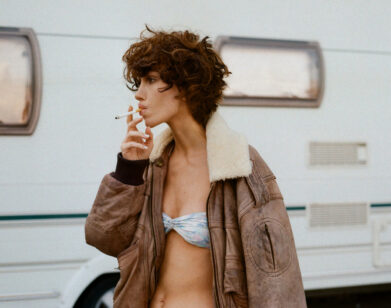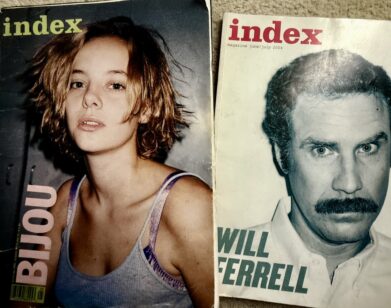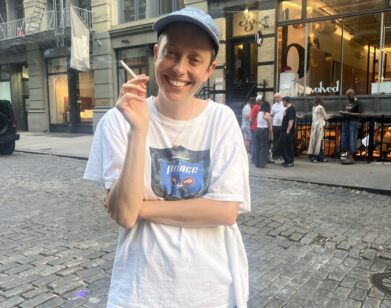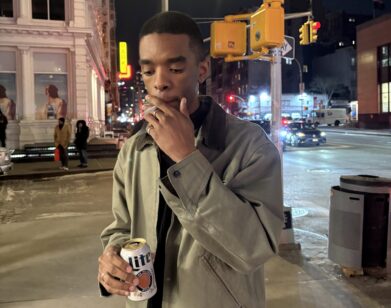Photographer Marie Tomanova Tells Ryan McGinley About Her American Dream Life
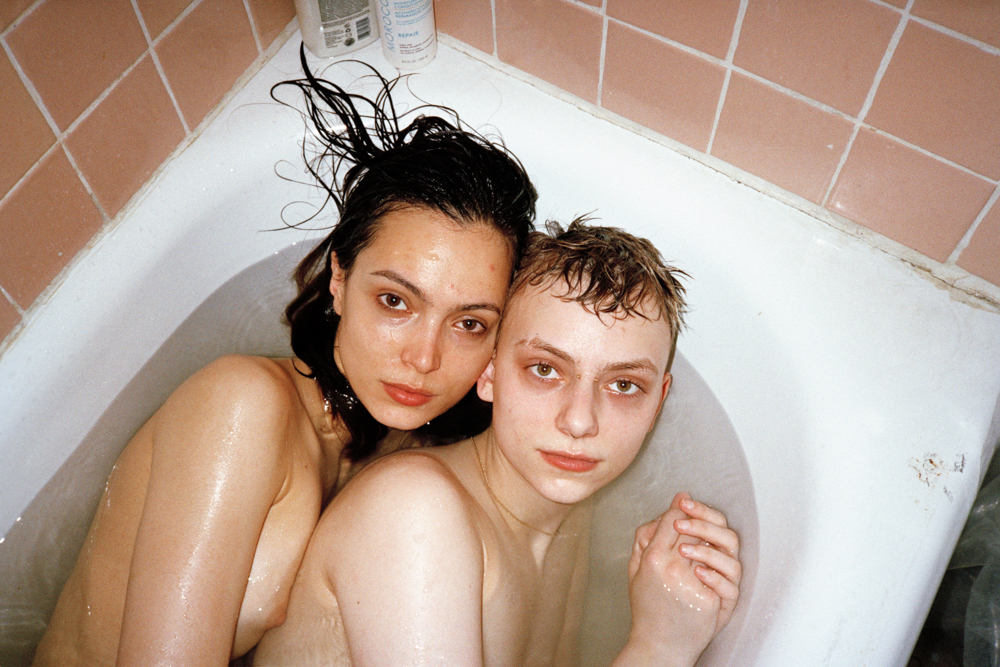
“Kate and Odie,” 2017.
If you want to see what one version of the future looks like, you have to turn the page back to 2017. It was the year photographer Marie Tomanova roamed downtown New York City looking for the future in the young faces of rave kids, aspiring artists, fashion people, and the loud personalities that swarm Canal Street. It’s a future, according to Ryan McGinley, “free of gender binaries and stale old definitions of beauty. In Marie’s world, people can just simply be. I wish all of America’s youth culture looked like Marie’s photos of downtown, diverse and inclusive.” Having made his legend photographing this same set of downtown kids, albeit 20 years prior, it’s fitting that McGinley would write these words in the introduction of Tomanova’s latest monograph, Young American. In effect, it’s a passing of the baton from one artist to another, with one constant — youth — bridging their bodies of work. In Tomanova’s portraits, which are conducted on-the-go after surreptitious encounters with subjects on the street, at parties, or even via DMs, there’s also a sense of willful assimilation. Her photographic practice began with her immigration to the United States in 2011, when she moved to North Carolina to work as an au pair. This essential fact of Tomanova’s biography makes her choice of subjects — inclusive and free of stereotypes — all the more meaningful. It also makes the singularized title of her book, comprised of images from a gallery show at the Czech Center New York’s New Bohemia Exhibition during the summer of 2018, deliciously cheeky. This is her American dream, Tomanova seems to suggest, before showing us that one person’s dream is, in actuality, a reality shared by us all. With the release of Young American, McGinley got on the phone with Tomanova to talk about her favorite bookstores, how to photograph animals, and the beauty of hustling in New York City. —NATHAN TAYLOR PEMBERTON
———
RYAN MCGINLEY: Do you remember how you looked at photographs back when you first started taking pictures? Where would you see them? How would you find them? Was there a website that you went to? Or Was there a book shop that had art books?
MARIE TOMANOVA: I didn’t have Instagram, yet. It was mainly Facebook. That was kind of the only way to even be in touch with friends back home. I think after moving to New York City, it was mainly about seeing shows and going to bookstores because New York had a whole other set of places where you could go and look at cool stuff.
MCGINLEY: Where were some of the places in New York that you would go?
TOMANOVA: The bookstore on St. Marks, which is not there anymore. Dashwood, of course. I love Printed Matter. Mast Books. All these little book stores that are around the East Village. Where do you go?
MCGINLEY: I still go to the Strand. That’s been my go-to for pretty much my entire time in New York. I’ve lived in the city for 20 years, now, and I still go to the Strand every two to three weeks. I go through different sections of that store and spend sometimes an hour, sometimes four hours. I think it’s probably the most amazing book shop in the world. It was just as important for me to go to the Strand as it was to go Parsons and study art there. You can spend as much time as you want in there. Nobody will ever say you’re here too long. It’s so big, and you can just get lost in so many different genres, whether you’re reading a book, or you’re looking at art books, or you’re looking at fashion or photography. Every section is so vast and endless.
TOMANOVA: I think saw your work for the first time on Tumblr, back in North Carolina. It was 2011, my first year in America. I saw a photograph that’s actually one of my favorites of yours. It’s a girl holding a wolf — or maybe she’s holding a coyote, but it looks kind of like a wolf. I always thought that wolf is my spirit animal, and when I saw that photo I was like, “Oh my god. I need to find everything I can about the person who shot that photo.” That’s how I got kind of hooked on your work. Was it really a wolf, Ryan?
MCGINLEY: I think it’s a coyote, actually.
TOMANOVA: She was really scratched. It looked really real. I loved it, and I still do.
NATHAN TAYLOR PEMBERTON: Can either of you tell me the biggest differences between taking portraits of humans and portraits of wild animals?
TOMANOVA: It’s not easy to establish a connection with an animal in the way you can with a human being, whom you can actually share some kind of a story with. It’s a hit or miss. Most of the time, I’ve been in New York City, taking pictures of people. But recently, I returned to my home in the Czech Republic. It’s a farm in a small town, and I realized that I used to be really focused on horses, for some reason. There are a lot of pictures of horses I painted before I left, so when I was back this time I actually photographed some of the animals on the farm. Horses, goats, bunnies, chickens, dogs — whatever was around.
MCGINLEY: I really love how unpredictable animals are. It creates an authentic moment. When you put an animal in somebody’s arms, there’s this sort of spirit that comes out of the model. People love animals. Most people love animals more than they love people. I always try to have animals around. I have a dog, and I always bring him on set. If you put an animal in people’s hands, there’s always something spontaneous that happens.
TOMANOVA: That’s beautiful. I have a cat. I used to have a dog in back home, but I had to leave her there when I left. I never saw her again.
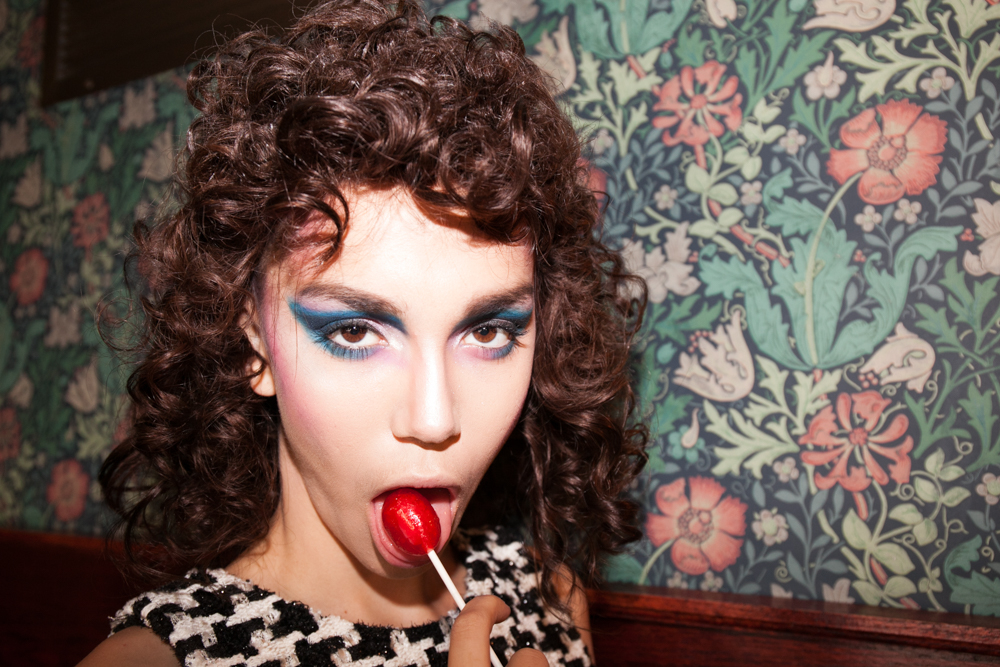
“Ally,” 2016.
PEMBERTON: What was it like to establish your artistic voice while establishing your place in the United States simultaneously, Marie? It’s seems like a parallel process of translation.
TOMANOVA: I think that they’re both that certain urge to fit in, to feel that I belong. It mostly happened through meeting all these young kids, hearing their stories, then sharing my story and creating connections in real life, while taking portraits. At the opening of Young Americans, a lot of the people in the pictures actually came. Seeing themselves really big, projected on the wall, created this beautiful energy in the room that I had never experienced before. I don’t really retouch any of the photos. None of them are wearing any extra makeup. There’s no special lighting. They’re just the way they simply are. It became about something more than just photographing people. It kind of created something for them as well.
MCGINLEY: There can be such a generosity in the connection between a photographer and a model. It’s a collaborative act where you’re making something together. Photographers bringing their point of view. The models bringing their spirit, their fashion sense, their vibe. It’s always a really beautiful exchange. I think it’s the same for any photographer when you release a book or when you have an expedition and somebody’s photo is in it. There’s that moment — it happens with all artists, even painters that paint portraits — where you get to be with the person and see the expression on their face when they actually see the picture. It’s a beautiful moment.
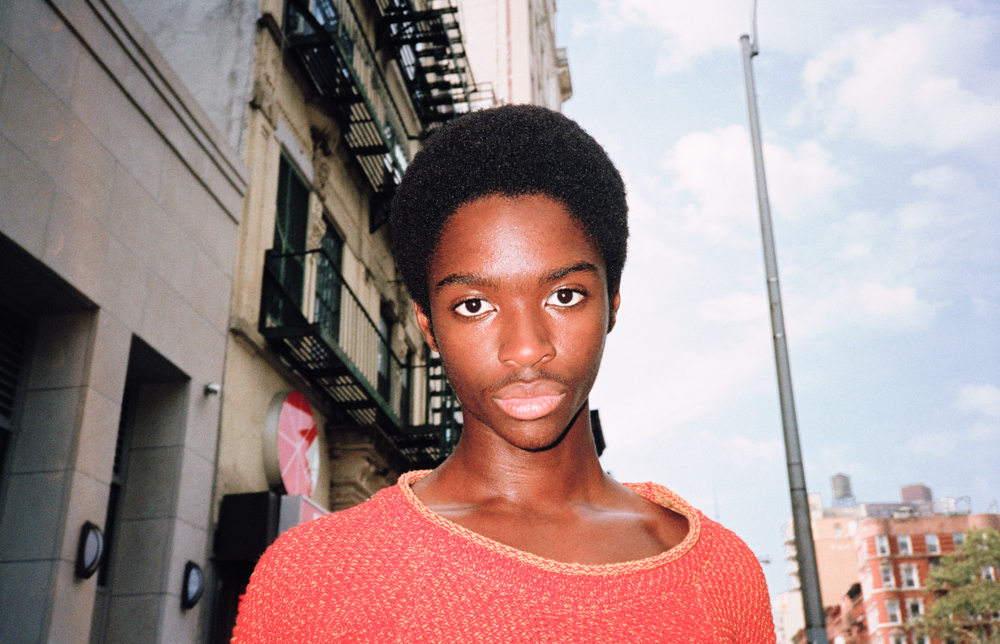
“Alton,” 2016.
PEMBERTON: What draws a photographer to such moments? It’s like you have a sixth sense for it. What is like when you finally find them?
MCGINLEY: You’re out a lot, Marie — at clubs, fashion shows, on the street. When I look at your work, I can feel a lot of that nightlife energy. For me, it feels like the reason I wanted to move to New York. There are so many people who have photographed downtown Manhattan and Brooklyn over the years, and there’s a very rich tradition of that, starting from the Beat generation and onwards.
TOMANOVA: New York has a very alive scene. I like to stop people walking around the city. New York City streets are the best! Or at art openings, stuff like that. This whole thing is a huge American dream for me. Even this interview, it’s really beautiful. Going back home and seeing my best friends who are still in the same town, in the same bars, I was really amazed I actually did manage to get out and come to New York City and fall in love with the place. It’s super fucking amazing and liberating to see that if somebody really dreams about something, even bigger than you dared to dream about it — it can happen.
MCGINLEY: I love the title of Marie’s book because I just think Marie is a young American. That’s why America’s beautiful, because it is so inclusive. New York creates all these amazing opportunities where you have access to people who you are inspired by, to people who inspire you, to people that can help facilitate your dreams. That’s exactly the reason why I moved here. I really admire you, Marie, because you came from a small farm in the Czech Republic. All I had to do was cross the George Washington Bridge from New Jersey. I always believed in the New York hustle. I think it is a real thing, and I love the spirit and tenacity of it. New York is a sink or swim city. People who have that hustle can swim.
TOMANOVA: There are kids who inspire me, who I admire because they are who they are. They are not afraid to be unique, to look different, to embrace their identities. I think there’s a lot of that in New York. It’s just very present. It creates a great energy in the city. Those are the kids that I love to photograph because I feel like those are the kids I belong to. I’m not an American yet. But I’m kind of hoping I will be, and I’ll be a proud American, I think.

